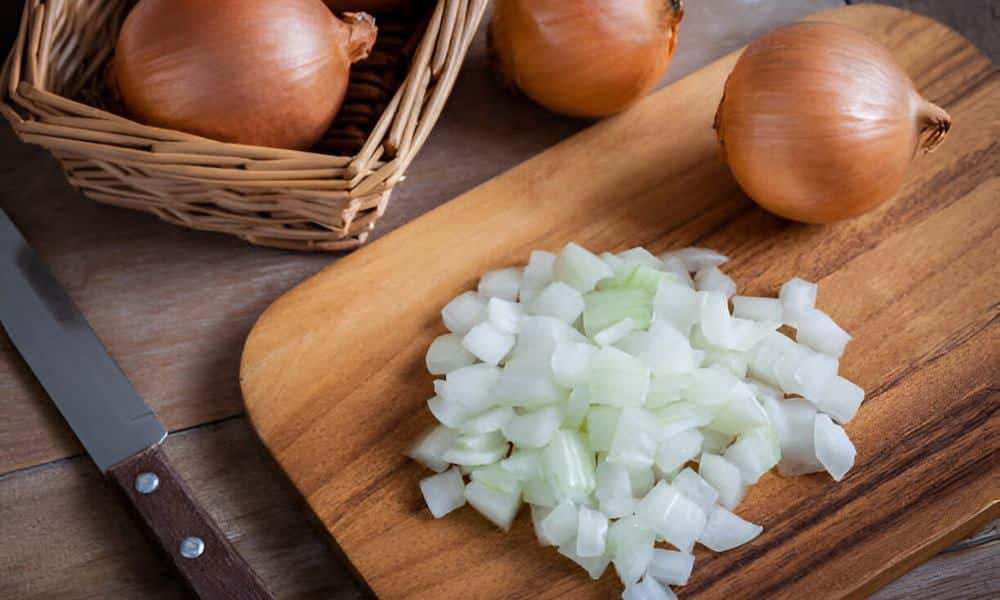Cutting onions is easy. Getting rid of the smell? Not so much. Last winter, I made a spicy lentil soup. The onions were strong. The board soaked it all in.The next day, I could still smell it. I cleaned it. I aired it out. Still, it lingered like a memory that wouldn’t fade. That’s when I knew I had to figure out how to get onion smell out of wood cutting board the right way.
I tested different tricks. Some worked. Some made things worse. Over time, I found the safest and simplest methods to fix it—without harming the wood.So, if your board smells like onions long after you’ve stopped chopping, this guide is for you.
Why Does Onion Smell Linger in Wooden Boards?
Wood is full of tiny holes and fibres. You can’t see them, but they’re there—like a sponge hiding behind smooth grain. These little spaces soak up oils and juices from foods. Onions, with their strong sulfur compounds, leave behind bold smells that love to settle deep in the wood.
That’s why rinsing alone doesn’t work. The surface looks clean, but inside, the smell stays trapped.
Softwoods hold on even more. Boards made from bamboo or cherry tend to grab smells faster. That’s not a problem if you know how to clean them the right way—something we’ll dive into next.
So, the next time smells funky, don’t blame your soap. It’s just the wood doing what it does—holding onto memories a little too well.
Step 1: Scrub with Coarse Salt and Lemon
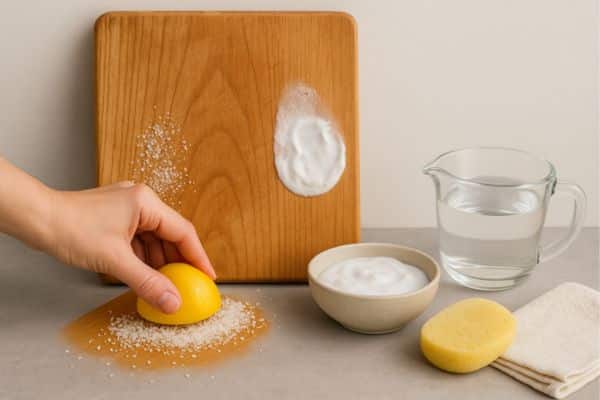
Grab some coarse salt—kosher salt works best. Sprinkle it across the board like you’re seasoning a roast. Cut a lemon in half. Use the cut side to scrub the salt into the wood. Use small circles and firm pressure. Let the mixture sit for five minutes. Then wipe it off with a clean, damp cloth.
Step 2: Apply a Baking Soda Paste
Make a thick paste using baking soda and a few drops of water. Spread it over the smelly area.Use a soft sponge or your fingers to rub it in. Don’t press too hard—let the paste do the work.
Step 3: Use White Vinegar (Optional)
This step is for deep odors. Mix equal parts white vinegar and water. Pour a little on the board or apply it with a clean cloth. Let it sit for just a minute. Too long, and vinegar can dry out the wood.
Step 4: Rinse, Dry, and Air Properly
After cleaning, rinse the board with warm water. Don’t soak it—just a quick rinse will do. Wipe it dry with a towel. Then stand it upright or lean it against the wall to air-dry fully. For the best cutting board for brisket, choosing the right one will make all the difference in your slicing and serving experience.
Bonus Tip – Deodorise Wooden Cutting Board Naturally
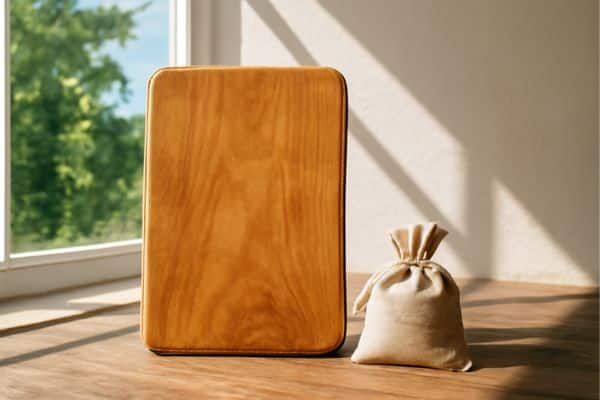
Sometimes a deep clean isn’t enough. That’s where natural deodorising comes in. It’s safe, easy, and doesn’t take much effort.
Let the Sun Work Its Magic
Place in direct sunlight for one to two hours. The heat helps release trapped odors from deep inside.
Use an Activated Charcoal Bag
Dry box or drawer. Add an activated charcoal bag nearby. Leave it overnight.
Try an Overnight Lemon Soak (The Safe Way)
Dampen a clean cloth with lemon juice. Lay it flat over the board. Leave it overnight on the counter.
My Favourite Cleaning Routine (That Actually Works)
I’ve tried a lot. Some methods smelled nice at first but didn’t last. Others cleaned too hard and left the wood dry and cracked. After plenty of trial and error, I found a routine that works every single time—without hurting the board.
Here’s what I do.
Right after chopping onions, I give the board a quick wipe with a damp cloth. Then I sprinkle a handful of coarse salt. I cut a lemon and scrub well. The salt pulls out the smell. The lemon cuts through the onion oil.
Next, I make a quick baking soda paste. I rub it in gently and let it sit for ten minutes. After that, I rinse with warm water and dry with a clean towel.
What Not to Do When Cleaning a Wooden Board
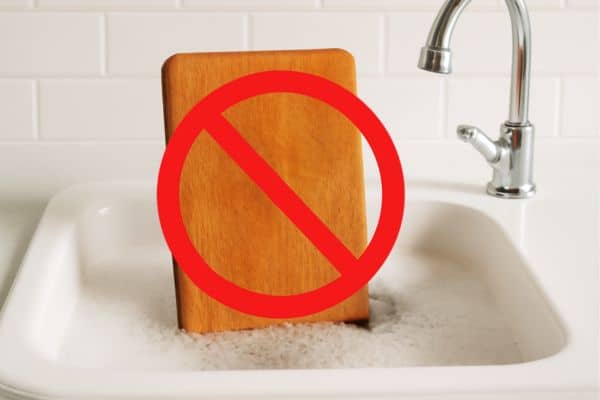
Some cleaning methods sound smart but can do more harm than good. Here are the biggest mistakes I’ve seen—and what to do instead.
Don’t Soak It in Water
Wood soaks up water fast. A long soak can cause cracks, warping, or even mould inside. Never leave your wooden board in water—rinse it quickly, then dry it well. Instead, use a damp cloth or sponge. Wipe it clean and dry it right away.
Skip the Bleach and Harsh Cleaners
Bleach can ruin the finish. It’s too strong for natural wood. It can also leave behind a smell worse than onions. Avoid bleach—it’s too harsh for wood and can damage over time. Try lemon, vinegar, or baking soda instead. They’re safe and just as effective.
Don’t Use a Dishwasher
The heat and water will break your board. I’ve lost a good one this way. Never put a wooden in the dishwasher—it won’t survive. Always hand-wash and air-dry it upright.
Best Practices to Prevent Onion Smell in the First Place
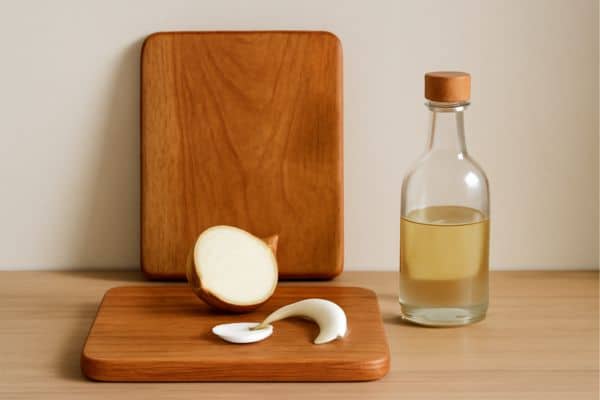
It’s easier to stop the smell than to fight it later. Over time, I’ve picked up a few habits that keep my boards clean and fresh—no scrubbing needed.
Use a Separate Board for Strong-Smelling Foods
I keep one small wooden board just for onions and garlic. It doesn’t have to be fancy—just reliable. Having a dedicated one helps keep your main one free from strong smells. This simple habit saves me a lot of trouble.
Clean It Right After Chopping
Don’t wait. I wipe my board down right after cutting onions. A damp cloth and a bit of salt go a long way. Cleaning fast stops the smell before it settles into the wood.
Oil It Regularly
Dry wood traps more smells. I rub food-grade mineral oil on my board every couple of weeks. It keeps the surface sealed and smooth. Oiling keeps moisture out and helps block odours. Make sure to dry the board upright, never flat. That helps air move around it and keeps the wood in shape.
Conclusion
Your cutting board doesn’t have to smell like yesterday’s onions. With a few easy steps and a bit of care, you can keep it clean, fresh, and ready for whatever you’re cooking next.
Try these methods at home. Start with salt and lemon. Mix in baking soda. Let the sun help now and then. Keep it dry, keep it oiled, and treat it like a kitchen companion—not just a tool.These tips come from real-life messes, real smells, and lots of trial runs.


